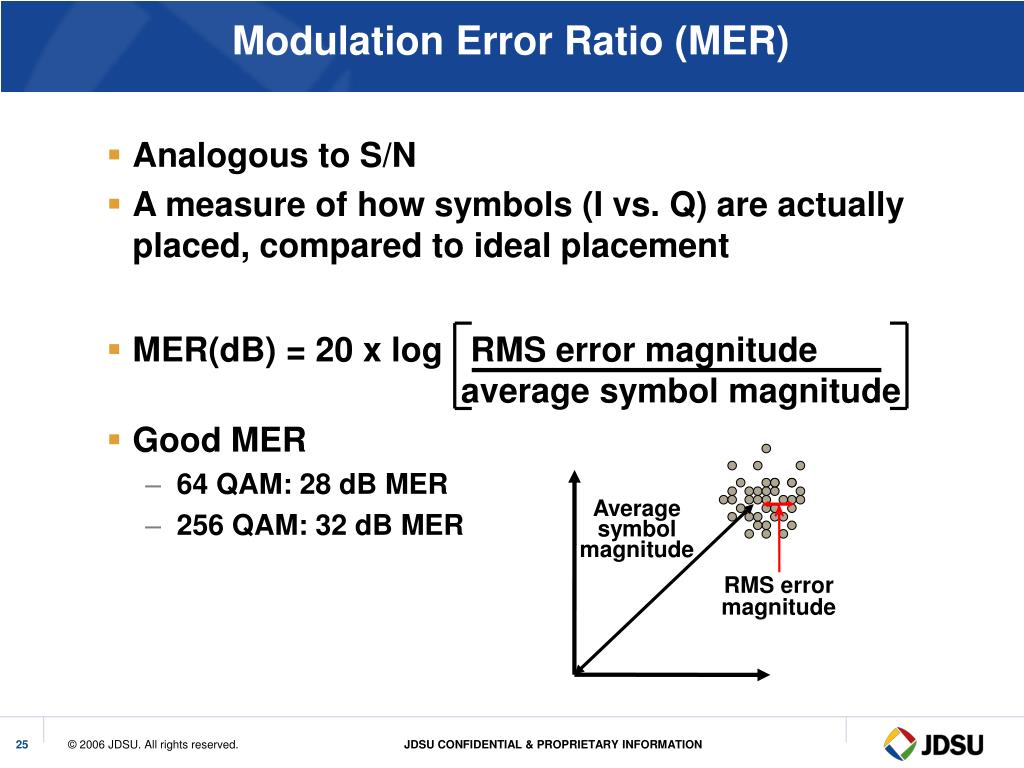
Bit Error Ratio curves using 64QAM modulation in Flat Rayleigh and... Download Scientific Diagram
Modulation Error Rate (MER) is a widely used measurement parameter in digital communications systems to evaluate the performance of the digital modulation scheme.

Modulation Error Ratio and SignaltoNoise Ratio Demystified Presented
What is Modulation Error Ratio (MER) and How Does it Affect Satellite Performance? Modulation Error Ratio (MER) is a measure of the quality of a digital signal, and.

Modulation Error Ratio and SignaltoNoise Ratio Demystified Presented
The modulation error ratio or MER is a measure used to quantify the performance of a digital radio (or digital TV) transmitter or receiver in a communications system using digital modulation (such as QAM ).

PPT Measuring Digital and DOCSIS Performance PowerPoint Presentation ID218862
The modulation error ratio (MER) is obtained by establishing the relation-ship between the rms value of the pay-load data and the effective error with-out reduction. The MER value in dB is thus always lower (worse) than the SNR value.

Bit error ratio performances of continuous phase modulation for space... Download Scientific
Modulation error ratio is the ratio, in decibels, of average symbol power to average error power: MER (dB) = 10log (average symbol power/average error power). From this, you can see that the fuzzier the symbol cloud—that is, the greater the average error power—the lower the MER.

Bit error ratio performances of continuous phase modulation symbols... Download Scientific Diagram
Classification of Modulation Error Rate Measurement using Convolutional Neural Networks in ISDB-T Abstract: This article proposes to perform detection and recognition of the modulations of the ISDB-T system and its measurement of the Modulation Error Rate (MER) through deep learning.

PPT VoIP Testing PowerPoint Presentation, free download ID4752660
What Is BER BER is abbreviation for Bit Error Rate. BER also known as Bit Error Ratio. Digital Signal meter or QAM analyzers are used in the measurement of BER. If bits are transmitted from one side and these are receiving at the other side then there will losses in the bits which are denoted by BER.

Probability of Bit Error Performance for Different PSK Modulation... Download Scientific Diagram
• Test configuration 6: Optical receiver + 3 amplifiers, 154 active QAM channels • Test configuration 7: Optical receiver + 3 amplifiers, 152 active QAM channels (lower and upper adjacent channels turned off), injected broadband noise for nominal 35 dB CNR (measured ACP with R&S EFA: -35.2 dBc)

PPT Overview PowerPoint Presentation, free download ID8231
Modulation Error Ratio By Ron Hranac One of the most widely used metrics for characterizing the health of digital signals carried in cable networks is modulation error ratio (MER), or more specifically, receive modulation error ratio (RxMER). As useful as RxMER is, it doesn't always tell the whole story. What is MER?

Bit Error Ratio curves using 64QAM modulation in Flat Rayleigh and... Download Scientific Diagram
This post defines the Modulation Error Ratio (MER) for QAM signals, and shows how to compute it. As we'll see, in the absence of impairments other than noise, the MER tracks the signal's Carrier-to-Noise Ratio (over a limited range). A Matlab script at the end of the PDF version of this post computes MER for a simplified QAM-64 system.

The comparison of DTTVSFN performance between modulation error ratio... Download Scientific
4 If N symbols are received, the MER is defined as the average: 𝐸 = 1 ∑ 𝐼 (𝑖)2+ (𝑖)2 𝐼(𝑖)2+ (𝑖)2 𝑁 𝑖=1 If N is large and all symbols are equally likely, we can calculate MER as the ratio of average target symbol

Bit Error Ratio using 4QAM modulation for different combinations of the... Download Scientific
Description The MER Measurement block computes a form of signal-to-noise ratio (SNR) measurement that you can use to assess the ability of a receiver to accurately demodulate a signal. Specifically, it returns the modulation error ratio (MER), minimum MER, and percentile MER for a received signal.

The Graph of D/U Ratio versus MER (Modulation Error Ratio) Download Scientific Diagram
The modulation error ratio or MER is a measure used to quantify the performance of a digital radio (or digital TV) transmitter or receiver in a communications system.

Bit error rates of QPSK, 8PSK, and 16QAM modulation with different... Download Scientific Diagram
Ensuring a high MER Good engineering practice suggests that operational MER be 3 to 6 decibels (dB) or more above the MER failure threshold for the modulation type in use. Good operational minimums are ~18 dB for quadrature phase shift keying (QPSK); ~24 dB for 16-QAM (quadrature amplitude modulation); ~27 dB for 64-QAM; and ~31 dB for 256-QAM.

PPT Measuring and Qualifying Upstream Signals PowerPoint Presentation ID3409603
MER: The average value of the Modulation Error Ratio (MER). MER Pk: is the peak level of the Modulation Error Ratio (MER). BER/CWER BER/CWER measurements only show when BER Analysis is selected under the Format tab. Bits Before LDPC: You can accumulate bit counts by enabling measurement averaging (MeasSetup > Average > RMS or RMS Exponential).

Why You Need to Measure Both BER and MER on QAM Digital Signals online presentation
The modulation error ratio or MER is a measure used to quantify the performance of a digital radio (or digital TV) transmitter or receiver in a communications system using digital modulation (such as QAM ).